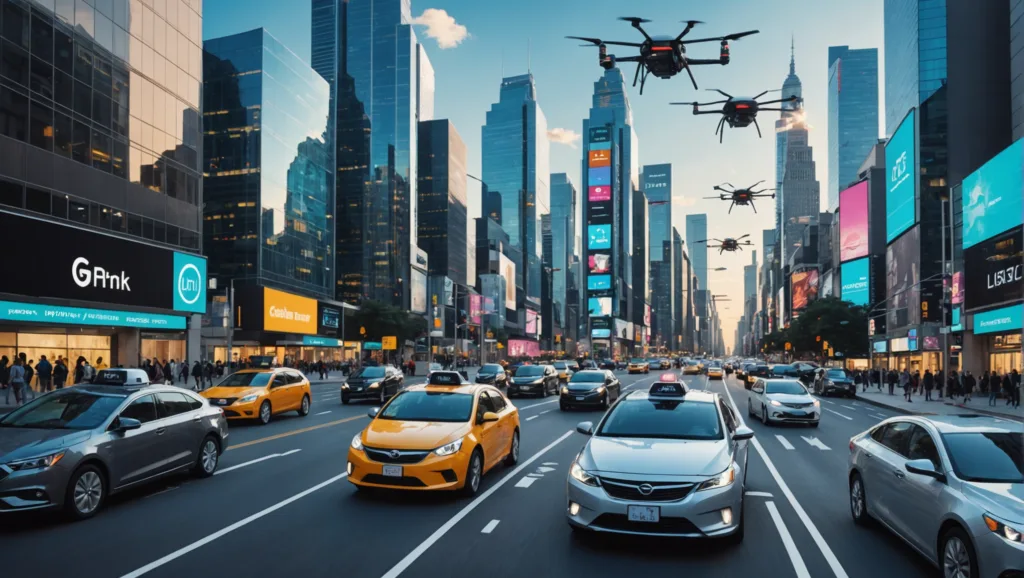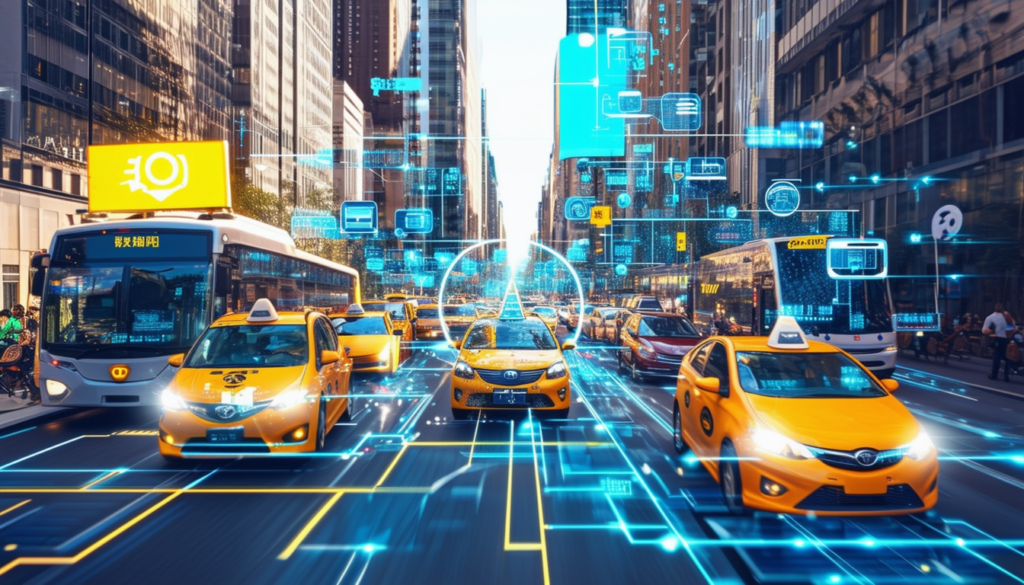Understanding the Concept of Ridesharing
Ridesharing is a contemporary form of transportation that integrates technology and communal values to deliver efficient services. Essentially, it is a modern variation of traditional carpooling, wherein two or more individuals share a vehicle to reach similar or nearby destinations for the mutual benefit of reducing costs and carbon footprints. Technology, primarily through smartphone applications, has evolved this concept by enabling users to connect and coordinate shared rides conveniently and effortlessly.
Ridesharing applications, such as Uber and Lyft, provide several benefits beyond cost-effectiveness. These benefits include flexibility where users can request rides at their own convenience and location, and increased reliability through advanced features like real-time tracking and estimated time of arrival (ETA). These applications have also broadened economic opportunities by creating flexible employment opportunities and driving user-friendly entrepreneurship.

However, it’s important to understand that while the term ‘ridesharing’ is predominantly used in the context of companies like Uber and Lyft, it broadly encompasses a wide array of shared transportation options.
How Smartphone Applications Have Transformed Transportation
In the current era of digital innovation, significant strides have been made in various sectors to accommodate the demands of a tech-savvy populace. Among the sectors experiencing monumental shifts, transportation stands tall, its transformation largely enabled by smartphone applications. Indeed, these applications have profoundly modified traditional travel modalities, imbuing convenience, efficiency, and accessibility. In the pre-smartphone era, public transportation or private vehicle ownership was the primary means of navigating cities. Now, the palm-held travel assistant has changed this dynamic, streamlining travel by providing real-time data on travel schedules, alternative routes, and crash reports, thereby aiding in optimal decision-making.
The advent of ridesharing applications is another considerable facet of this transformation. These applications have presented a more systematic, user-friendly approach to ridesharing and carpooling, thus changing private vehicle ownership’s necessity landscape. The interaction between drivers and passengers has been made seamless, eliminating the need for physical flagging down of taxis or scheduling rides in advance. They offer the privilege of accessing and booking rides at any time and from any place, thereby bridging crucial gaps in traditional transportation services and diversifying mobility options. The software algorithm’s ability to match riders moving in the same direction has increased dynamic routing capabilities, contributing significantly to this sector’s digital overhaul.
The Impact of Ridesharing on Traditional Transportation Systems
Ridesharing has profoundly transformed the urban transportation landscape, effectively challenging the dominance of traditional modes of public transport. In cities worldwide, ridesharing applications, such as Uber and Lyft, have penetrated deeply, offering a competitive, often more affordable, and convenient alternative to conventional taxi services and public transportation. Convenience shines through as the strongest attribute, with the ability to book a ride anytime and anywhere, directly from one’s smartphone.
However, this has undeniably led to a significant decline in the usage of traditional taxis and buses. Taxi drivers and operators have faced a sharp reduction in their customer base, as commuters increasingly prefer the comfort and convenience ridesharing services offer. Additionally, public transit systems, already strained under budgetary constraints, face a new threat as commuters switch allegiance to these emerging service providers. Ridesharing’s growing popularity is not to blame solely, it is the adaptability and refusal to evolve of traditional transportation systems that has hastened their decline.

The Role of GPS in Facilitating Ridesharing
Global Positioning System (GPS) technology has become an indispensable aspect of modern ridesharing services. It enables passengers to pinpoint their exact location and dispatch a ride request to nearby drivers. Furthermore, the GPS helps rideshare drivers to locate customers efficiently and guide them through the fastest routes to their destinations, especially in heavy traffic areas and congested city streets. This real-time information provided by GPS technology eliminates any guesswork and contributes significantly to the convenience, effectiveness, and overall customer experience of rideshare services.
In addition to facilitating navigation and improving the quality of service, GPS technology serves as a safety mechanism in ridesharing applications. Most rideshare companies use built-in GPS tracking during trips, offering an extra layer of security for both passengers and drivers. If an unforeseen circumstance occurs, such as a breakdown or accident, the location data can be quickly utilized to send requisite help. Hence, the role of GPS technology extends beyond user convenience and deeply ingrains itself into the operational infrastructure and safety measures of ridesharing services.
GPS technology plays a crucial role in the ridesharing industry by:
- Enabling precise location tracking: GPS allows passengers to share their exact location with drivers. This ensures that drivers can find customers quickly and efficiently, without wasting time searching for pickup points.
- Facilitating efficient navigation: With real-time traffic updates and route suggestions, GPS helps drivers choose the fastest routes to destinations. This is particularly useful in congested city streets where finding an optimal path can be challenging.
- Improving service quality: By eliminating guesswork related to locations and routes, GPS enhances the overall customer experience of rideshare services. Passengers enjoy timely pickups and drop-offs while drivers benefit from streamlined operations.
The safety benefits offered by GPS technology include:
- Providing real-time tracking during trips: Most rideshare companies utilize built-in GPS tracking throughout journeys. This continuous monitoring adds an extra layer of security for both passengers and drivers.
- Assisting in emergency situations: In case of accidents or breakdowns, immediate access to location data enables quick dispatching of requisite help or support services.
In conclusion, GPS technology is not just a tool for convenience but also a critical component contributing towards operational efficiency and safety protocols within the rapidly evolving ridesharing landscape.
Economic Implications of Ridesharing Services
The advent of ridesharing services has reshaped the economic landscape of the global transportation industry. Through their innovative use of digital technology, these services have not only democratized the industry but also laid down a blueprint for its future. Customers can access reliable transportation with a few taps on their smartphone, and drivers can earn a steady income by leveraging their personal vehicle.
While ridesharing services are a convenient transportation option that benefits many, they also present economic implications worth exploring. As more money is channeled into ridesharing apps, taxicab companies and other traditional modes of transportation may suffer financially. Simultaneously, these apps have generated a significant economic boost by creating flexible employment opportunities and injecting capital into local economies worldwide. It is this rather complex interplay that renders the accurate assessment of the economic impact of ridesharing a multifaceted task.

Environmental Benefits of Ridesharing Apps
The introduction of ridesharing applications, such as Uber and Lyft, have significantly contributed to a marked decrease in pollution levels across the globe. Carpooling, a primary feature of these apps, pairs passengers traveling in similar directions, thereby reducing the number of vehicles on the road. This considerable reduction in traffic implicitly slashes the amount of greenhouse gas emissions. Not to mention, the smaller volume of traffic also lessens the severity of city congestion, promoting a more efficient flow of vehicles through urban landscapes.
Furthermore, these ridesharing platforms are also actively encouraging the use of electric and hybrid vehicles by offering numerous incentives and benefits to their drivers. Utilizing energy-efficient vehicles does not only minimize the carbon footprint, but also positively affects fuel economy.
Moreover, there is a considerable decrease in the consumption of non-renewable resources. Thus, ridesharing applications are paving the way to a more sustainable environment by incorporating environmentally-friendly practices into their business models.
Challenges and Controversies Surrounding Ridesharing Apps
The implementation of rideshare apps has not, however, been without challenges and controversies. First of these is the increased competition that traditional taxi services now face. With the convenience and cost-effectiveness provided by the likes of Uber and Lyft, many customers have made the switch from regular taxis to these more modern alternatives. Such a shift has sparked several protests worldwide, especially from taxi drivers and unions who believe that rideshare companies are operating unfairly, often operating without the same level of regulations and requirements imposed on traditional cab services.
Secondly, the issue of safety and security has also been a recurring concern. Unlike traditional taxis, anyone with a driver’s license and a decent car can become a driver for most ridesharing companies. Stringent background checks may not always be mandatory, exposing passengers to potential risks while traveling.
Furthermore, the work conditions for drivers working with these platforms are also a point of contention, with arguments such as low wages, lack of job security, and absence of benefits plaguing the ridesharing industry. In addition to these, data privacy concerns also loom large over these apps, raising questions about how user information is managed and protected.
FAQs:
What exactly is the concept of ridesharing?
Ridesharing is a service that arranges one-time shared rides on short notice by using smartphone technology and GPS to connect riders and drivers. These services are a modern alternative to traditional taxi services, often being cheaper and more convenient.
How have smartphone applications transformed transportation?
Smartphone applications, such as Uber and Lyft, have revolutionized transportation by making it more convenient for users to secure rides. These apps allow users to request a ride at their location, track their driver’s arrival, rate their experience, and pay electronically in real time, eliminating the need for cash transactions.
What is the impact of ridesharing on traditional transportation systems?
Ridesharing apps have significantly disrupted traditional transportation systems, particularly taxi services. They have introduced fierce competition, leading to a decrease in taxi usage in many cities. However, they’ve also provoked discussions about regulation and labor rights as they operate differently from traditional transportation systems.
How does GPS play a role in facilitating ridesharing?
GPS technology is crucial in ridesharing services. It enables the tracking of the vehicle’s location, estimation of arrival times, and calculation of fares based on the distance traveled. This makes ridesharing services more transparent and reliable.
What are the economic implications of ridesharing services?
Ridesharing services have created new job opportunities for drivers and provided an affordable transportation option for riders. However, they’ve also raised concerns about wages, job security, and competition with traditional taxi services.
Can you elaborate on the environmental benefits of ridesharing apps?
Ridesharing apps can contribute to a reduction in carbon emissions by minimizing the number of cars on the road, especially if rides are shared by multiple passengers. This could contribute to a decrease in traffic congestion and air pollution.
What are some of the challenges and controversies surrounding ridesharing apps?
Ridesharing apps have been subject to several controversies, including concerns over driver’s wages, job security, and working conditions. There are also safety concerns for both drivers and passengers and issues around the lack of regulation and oversight. Additionally, while they may reduce the number of personal cars on the road, ridesharing services could potentially increase overall vehicle miles traveled and associated emissions.

Sanela Isakov
Sanela is a passionate advocate for environmentally conscious living. With a background in environmental science, she brings a wealth of knowledge to our community, inspiring readers to make sustainable choices in their daily lives. Join Sanela on a journey toward a greener, more sustainable future.


 Ridesharing For A Greener Future | Benefits And Strategies
Ridesharing For A Greener Future | Benefits And Strategies
